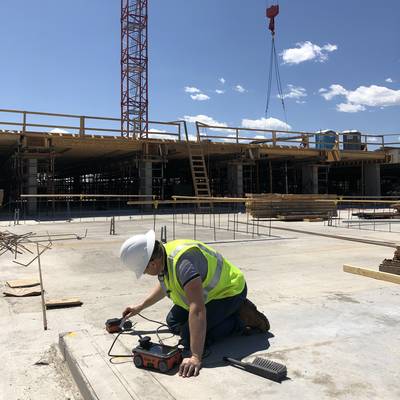Trick Benefits of Making Use Of Concrete Scanning Technology
Trick Benefits of Making Use Of Concrete Scanning Technology
Blog Article
Unveil the Transformative Power of Concrete Scanning in Optimizing Efficiency and Safety And Security
Concrete scanning has arised as a crucial tool in the building and construction market, providing unrivaled advantages in enhancing task performance and ensuring safety requirements. The transformative power of concrete scanning lies in its capability to offer detailed understandings and real-time data, changing just how projects are prepared and implemented.
Importance of Concrete Scanning
Guaranteeing the structural integrity and security of construction jobs begins with the crucial action of carrying out extensive concrete scanning. Concrete scanning is a non-destructive approach made use of to discover and map subsurface components within concrete structures.
Additionally, concrete scanning aids in maximizing job timelines and spending plan by preventing unforeseen expenses and delays that might arise due to unforeseen obstructions within the concrete. Ultimately, investing in thorough concrete scanning is a positive technique that enhances both performance and security in building tasks.
Just How Concrete Scanning Works
Concrete scanning operates as a critical tool in building projects by utilizing sophisticated modern technologies to discover and map subsurface aspects without creating structural damage. Ground Penetrating Radar (GPR) and Electromagnetic Induction (EMI) are 2 main techniques made use of in concrete scanning.
During the scanning process, the information collected is examined in real-time, allowing immediate recognition of potential dangers or obstacles beneath the surface. This information help in decision-making, guaranteeing that building tasks continue securely and efficiently. Furthermore, 3D imaging software program can be made use of to produce topographic maps of the subsurface elements, additionally improving project planning and implementation. By utilizing these advanced innovations, concrete scanning dramatically reduces the risk of expensive problems and injuries on building websites.
Advantages of Concrete Scanning
Using innovative scanning modern technologies in construction tasks offers a multitude of benefits, enhancing both performance and security on-site. Among the primary advantages of concrete scanning is the capacity to detect and situate embedded things such as rebar, post-tension cables, and channels accurately. By determining these components before boring or cutting right into concrete structures, the danger of accidental strikes is considerably minimized, preventing potential injuries to employees and damages to the structure itself. Furthermore, concrete scanning aids in planning and making better, as it gives exact info concerning the location and deepness of structural components.

Instance Studies: Concrete Scanning Success

In an additional instance, a building and construction firm utilized 3D concrete scanning to analyze the condition old concrete structures in a historical structure. The detailed scans offered valuable understandings into the degree of wear and tear and assisted focus on maintenance efforts efficiently. By proactively resolving locations of issue identified via scanning, the business had the ability to extend the life-span of the structure and guarantee occupant safety.
These study highlight the transformative power of concrete scanning in improving performance, accuracy, and safety and security in construction jobs.
Carrying Out Concrete Scanning in Projects
Applying sophisticated scanning technologies throughout building tasks has actually come to be significantly crucial for enhancing accuracy and security. By incorporating concrete scanning right into project preparation and execution, building and construction teams can recognize potential dangers, such as rebar or post-tension cables, concealed within concrete frameworks. This aggressive webpage approach lessens the danger of mishaps, hold-ups, and pricey rework, inevitably resulting in more efficient project timelines and budgets.
To apply concrete scanning properly, task managers ought to work together very closely with skilled scanning specialists to identify one of the most ideal scanning techniques for the specific project requirements. Engaging scanning specialists from the beginning of a project this page allows the group to develop thorough scanning plans that deal with essential areas of issue and ensure thorough information collection.
Moreover, integrating concrete scanning right into regular project operations can streamline decision-making procedures, as real-time scan data offers prompt insights right into the condition of concrete frameworks - Concrete Scanning. This data-driven strategy facilitates notified analytic and makes it possible for groups to make modifications promptly, promoting a society of performance and security throughout the project lifecycle

Final Thought
Finally, concrete scanning plays an essential role in improving efficiency and safety and security in building jobs. By utilizing innovative innovation to identify and map out underlying frameworks within concrete, this procedure assists to avoid expensive mistakes, make sure architectural honesty, and lessen risks on site. With the ability to discover covert aspects and provide precise data, concrete scanning verifies to be an important tool for maximizing job outcomes and making best use of total success.
Concrete scanning is a non-destructive technique utilized to discover and map subsurface elements within concrete frameworks. Furthermore, concrete scanning helps in maximizing job timelines look what i found and spending plan by preventing unexpected prices and delays that might develop due to unpredicted blockages within the concrete. One noteworthy case research entails a massive remodelling job where concrete scanning played a vital duty in ensuring task success.In another instance, a building and construction business made use of 3D concrete scanning to assess the problem of aging concrete frameworks in a historic structure. By incorporating concrete scanning into job planning and implementation, building groups can recognize prospective hazards, such as rebar or post-tension cables, hidden within concrete frameworks.
Report this page